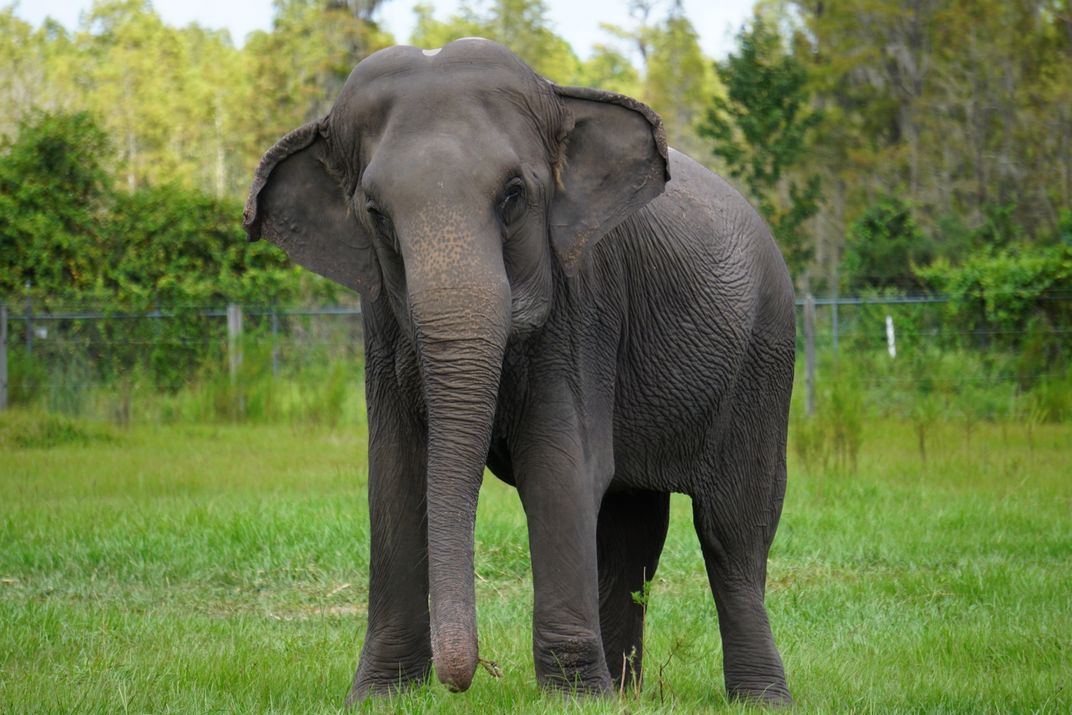Retired Circus Elephants to Move to 2,500-Acre Wildlife Refuge Next Year
Since 2016, about 30 elephants have lived in a 200-acre enclosure managed by Ringling Bros. circus
/https://tf-cmsv2-smithsonianmag-media.s3.amazonaws.com/filer/bb/25/bb25bcef-93b9-4d82-9dfe-3adbda9f8765/2020_sep28_elephants7.jpg)
About 30 Asian elephants previously used in Ringling Bros. and Barnum & Bailey Circus performances will move to the White Oak Conservation Center in Florida next year. The conservation center is committing 2,500 acres of its over 17,000-acre property as the elephants’ new home, and expects the first elephants to arrive next year, the Associated Press reports.
Feld Entertainment, which owns the circuses, committed to phasing out elephant performances in 2015, and officially retired the last of its elephants in 2016, Oliver Whang reports for National Geographic. Since then, the elephants have lived at the Ringling Bros.’ 200-acre Center for Elephant Conservation. When Reuters’ Barbara Goldberg described conditions at the center in 2016, the elephants were chained at night to prevent them from stealing each other’s food.
The White Oak Conservation Center announced its purchase of 35 retired circus elephants on September 23. Some of the elephants won’t be able to move to the wildlife refuge because of age or medical conditions—one is 74 years old, and another is blind, so they will probably stay behind, Teresa Stepzinski reports for First Coast News. But White Oak will take over caretaking of the elephants at the Center for Elephant Conservation.
White Oak’s elephant enclosure is about four square miles of wetlands, meadows and woods that will provide a variety of landscapes for the animals to choose from. The space will have 11 watering holes that are large enough for the elephants to wade in, as well as three barns stocked with veterinary equipment to meet the elephants’ needs.
“It is a chance for us to let them return to just being elephants in a situation that is as close to the wild as we can make,” Michelle Gadd, who leads global conservation efforts for Walter Conservation, to National Geographic.

The White Oak Conservation Center, which is located about 35 miles north of Jacksonville, Florida, is also home to species like rhinoceroses, okapis, gazelles and cheetahs.
Twenty-six female elephants and eight males are eligible to move to the White Oak conservation center, per First Coast News, but there are challenges to such a big transition. The eligible elephants range in age from eight to 63 years old, they have lived their lives in near-isolation, and they have never foraged for their own food.
"Our elephant whisperer Nick [Newby], who's in charge of the elephant program for us, has been spending his time getting to know these elephants and their social preferences, limitations and physical ailments for the past two years," Gadd tells First Coast News. "It's to see who tolerates each other, who really likes each other, who stays together and gets along well."
For example, Newby found a group of six elephants between ten and 55 years old—named Kelly Ann, Mable, Luna, Cora, Osgood and April—that get along with each other, and could be moved together. The conservation center also plans to keep family groups, like calves with their mothers or siblings, together whenever possible, according to the center’s statement.
Because the elephants have lived in captivity for their whole lives, they cannot be returned to their natural habitat in India and Southeast Asia. But Ed Stewart, president of the Performing Animal Welfare Society, tells National Geographic that this transition, from the Center for Elephant Conservation to White Oak Conservation Center, is a step in the right direction.
“It looks like it’s going to be very good captive welfare, some of the best captive welfare that you can have,” Stewart tells National Geographic.
Asian elephants are endangered, and live in only about 15 percent of their original habitat. About a third of their population today live in captivity, used for agriculture, logging and tourist attractions in India, Thailand and Myanmar, National Geographic reports. Elephant trainers employ fear- and pain-based methods to elicit the behavior they want from the animals.
The staff at the White Oak Conservation Center hope to return any elephants born at the center to the wild, a feat that hasn’t been accomplished before. Even if the elephants all remain at the center, Gadd tells National Geographic that it is a “really important experiment about how well elephants can relearn wild behaviors.”